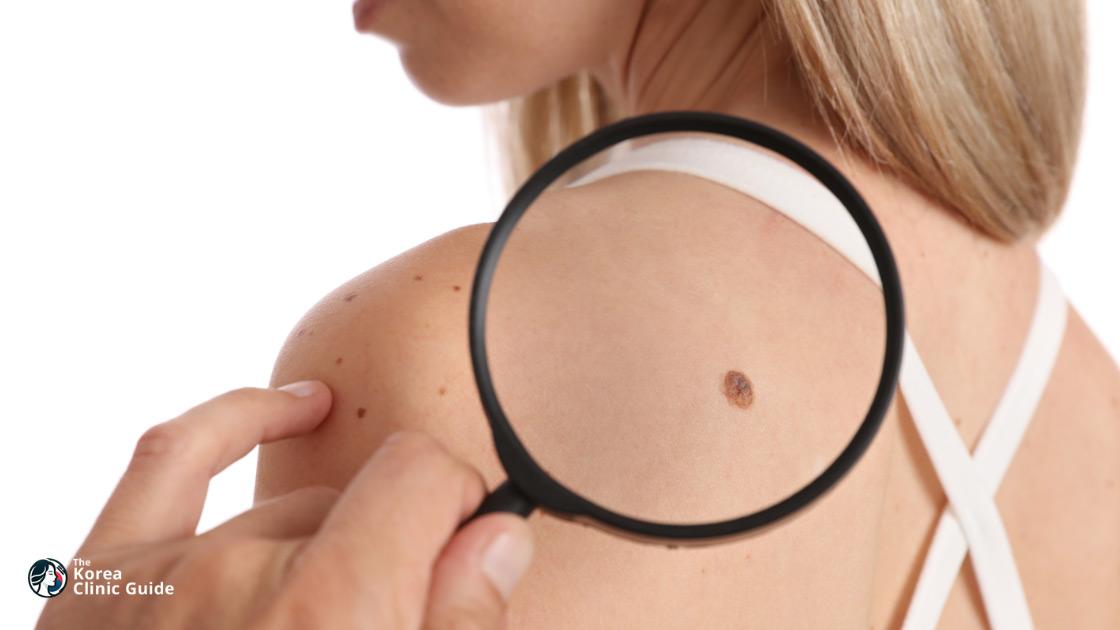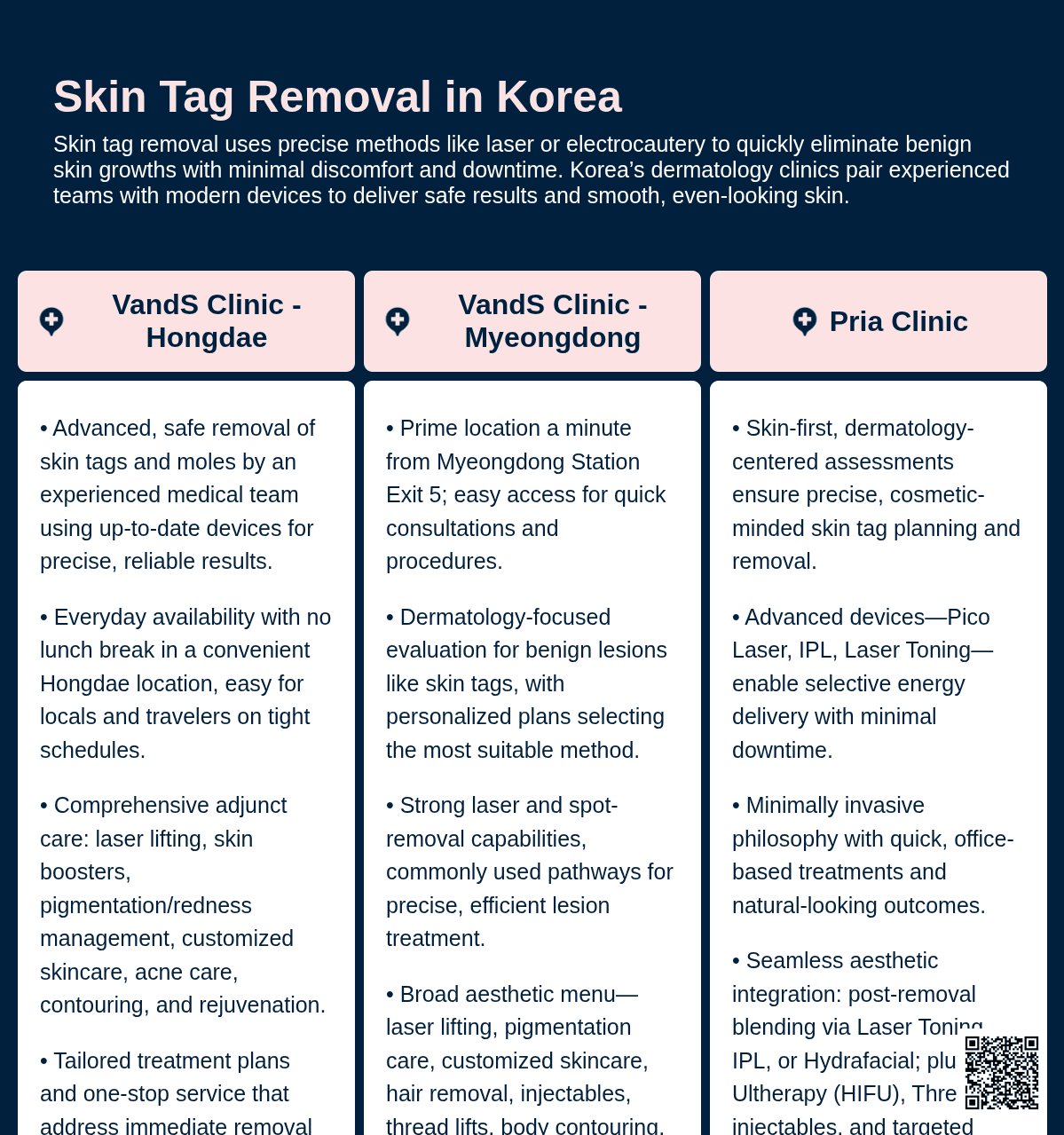Medical Tourism Blog
Skin Tag Removal in Korea | Best Clinics, Costs, Procedure Types & More

Table of contents
- What Is Skin Tag Removal?
- Best Clinics in Korea for Skin Tag Removal
- Getting Skin Tag Removal in Korea
- Cost of Skin Tag Removal in Korea
- Alternatives to Skin Tag Removal
- Conclusion
Considering treatment in Korea? Everything you need to know e.g. — how to avoid scams, visas, interpreters, recovery tips — in our Medical Tourism Master Guide. Plan with confidence in minutes, not weeks!
Are you tired of dealing with unsightly skin tags that disrupt your confidence? Discover why Korea is becoming a leading destination for skin tag removal, offering cutting-edge medical technology and top-notch care that promises not only effective results but also an affordable solution for enhancing your aesthetic appeal.
What Is Skin Tag Removal?
Skin tag removal is a medical procedure aimed at eliminating benign, soft, skin-colored growths known as skin tags or acrochordons. These growths can appear on various parts of the body, particularly in areas where skin rubs against skin or clothing, such as the neck, armpits, groin, eyelids, and under the breasts.
Causes and Diagnosis
Skin tags are typically benign and harmless. They can occur due to friction, hormonal changes, or a common family trait. While they are generally painless, skin tags can become irritated from rubbing against clothing or jewelry. A healthcare professional often diagnoses skin tags through a physical examination, though a biopsy might be taken to rule out other skin conditions if there's any uncertainty.
Methods of Skin Tag Removal
-
Cryotherapy
- Procedure: This method entails applying liquid nitrogen to freeze the skin tag, causing it to fall off within a few days or weeks.
- Duration: The procedure usually takes a few minutes per tag.
- Aftercare: The affected area might blister for a short period. Keeping the area clean and dry is crucial to prevent infection.
-
Electrosurgery (Cauterization)
- Procedure: A focused electric current burns off the skin tag. This method can be quick but might require local anesthesia to minimize discomfort.
- Duration: Each tag can be removed in less than 15 minutes.
- Aftercare: Patients are often advised to avoid scrubbing the treated area and to keep it protected from excessive moisture.
-
Ligation
- Procedure: This involves tying off the skin tag at its base with surgical thread to cut off blood supply, causing the tag to wither and fall off.
- Duration: The tag generally falls off within a week.
- Aftercare: Minimal, but attention should be paid to avoid irritation at the ligation site.
-
Excision
- Procedure: The skin tag is cut off with a scalpel or surgical scissors. Local anesthesia is usually administered to alleviate pain.
- Duration: Each tag typically takes 15-30 minutes to remove, depending on its size.
- Aftercare: The patient should follow care instructions to minimize the risk of infection and scarring, including keeping the area clean and avoiding tight clothing.
-
Laser Surgery
- Procedure: A laser precisely targets and vaporizes the skin tag tissue.
- Duration: This method is often preferred for its speed and efficiency, usually taking just a few minutes.
- Aftercare: Proper wound care is essential to ensure proper healing and prevent scarring.
Potential Side Effects and Risks
While most skin tag removal procedures are safe, potential side effects can include minor pain, infection, and scarring. Patients are typically advised to follow post-procedure care instructions diligently to minimize these risks.
Who Can Benefit from Skin Tag Removal?
- Individuals Experiencing Irritation or Bleeding: Skin tags that frequently rub against jewelry, clothing, or seat belts can become irritated and bleed.
- Those with Skin Tags on Eyelids: Skin tags around the eyes can affect vision and may need removal for better eyesight.
- People with Painful Skin Tags: While most skin tags are painless, some can cause discomfort, particularly if they are repeatedly irritated or pulled.
- Those with Multiple Skin Tags: Having numerous skin tags could sometimes indicate other health conditions, and seeing a dermatologist can provide a proper diagnosis.
- Aesthetic Concerns: Many people seek removal due to cosmetic reasons. Although insurance may not cover these cases, removing skin tags can improve self-esteem and overall satisfaction with appearance.
- Individuals at Higher Risk: People who are overweight, pregnant, have loose skin, diabetes, metabolic syndrome, or a family history of skin tags may find themselves dealing with these benign growths more frequently.
- Concerned about Misdiagnosis: Since skin tags can be mistaken for other conditions like warts or even skin cancer, professional diagnosis and removal by a dermatologist ensure accurate identification and treatment.
Best Clinics in Korea for Skin Tag Removal
Listed below are the best clinics in Korea for skin tag removal:
| Clinic Name | Key Features | Special Techniques |
|---|---|---|
| VandS Clinic - Hongdae | Advanced techniques for safe skin tag and mole removal; skilled, experienced medical team using the latest technology; open every day with no lunch break; convenient Hongdae location; tailored plans and one-stop care for locals and visitors. | Laser lifting; skin boosters; pigmentation and redness care; customized skincare; acne care; contouring; rejuvenation. |
| VandS Clinic - Myeongdong | Just a minute’s walk from Myeongdong Station Exit 5; dermatology-focused care for benign concerns like skin tags; personalized consultations; comprehensive, professional, tailored services. | Laser treatments; Acne Treatment/Spot Removal; Laser Lifting; Whitening/Freckles/Redness/Pigmentation care; customized Skincare; Hair Removal; Botox/Contour Injection; Filler/Thread Lifting; Zero Fat Injection; Skin Boosters; IV Therapy; Semi-permanent Makeup. |
| Pria Clinic | Dermatology-centered approach with skin-first planning; minimally invasive, efficient care with natural-looking results; convenient Gangnam Station location; patient comfort and streamlined treatments; comprehensive menu under one roof. | Laser Toning; Pico Laser; IPL; Ultherapy (HIFU); Thread Lift; injectables (Botox, fillers); Hydrafacial; targeted body contouring; post-removal blending with Laser Toning, IPL, or Hydrafacial. |
VandS Clinic - Hongdae
VandS Clinic – Hongdae stands out as a top choice for skin tag removal in Korea by combining advanced techniques for safe skin tag and mole removal with a skilled, experienced medical team that uses the latest technology to deliver dependable results. Conveniently located in Hongdae and open every day without a lunch break, the clinic makes treatment easy to fit into any schedule, whether you’re a local resident or visiting from abroad. Beyond precise removal, VandS Clinic supports clearer, more even-looking skin through a comprehensive range of complementary services—such as laser lifting, skin boosters, pigmentation and redness care, and customized skincare treatments—allowing tailored plans that address both the immediate concern and overall skin quality. With broad expertise that spans acne care, contouring, and rejuvenation, the Hongdae branch provides a comfortable, one-stop setting to achieve smooth, confident skin.
Find more about this clinic here: VandS Clinic - Hongdae Website
VandS Clinic - Myeongdong
VandS Clinic Myeongdong Branch is a conveniently located cosmetic and dermatological clinic just a minute’s walk from Myeongdong Station Exit 5. For visitors seeking solutions for benign skin concerns such as skin tags, the clinic’s dermatology-focused offerings—particularly laser treatments and acne/spot removal services—provide common pathways used to address unwanted lesions, with personalized consultations to determine the most suitable approach.
Beyond lesion-focused care, VandS Clinic provides a comprehensive menu of treatments, including Laser Lifting, Acne Treatment/Spot Removal, Whitening/Freckles/Redness/Pigmentation care, customized Skincare, and Hair Removal. The clinic also offers Anti-aging options like Botox/Contour Injection and Filler/Thread Lifting, Body Contouring with Zero Fat Injection, Skin Boosters, IV Therapy, and Semi-permanent Makeup, delivering professional, tailored services to help clients achieve their aesthetic goals.
Find more about this clinic here: VandS Clinic - Myeongdong Website
Pria Clinic
Pria Clinic, conveniently located at Gangnam Station in Seoul, specializes in advanced aesthetic and dermatological care dedicated to enhancing skin health and appearance. With a comprehensive suite of in-clinic treatments—ranging from precision energy devices like Laser Toning, Pico Laser, and IPL, to non-surgical lifting with Ultherapy (HIFU) and Thread Lift, as well as injectables, Hydrafacial, and targeted body contouring—Pria Clinic emphasizes effective, minimally invasive solutions and natural-looking results with thoughtful, skin-first treatment planning.
- Dermatology-centered approach: A focus on skin health and appearance means careful evaluation and tailored treatment for minor skin concerns, making skin tag assessment and removal both precise and cosmetic-minded.
- Advanced device portfolio: Pico Laser, IPL, and Laser Toning provide controlled, selective energy delivery that supports precise work on small, localized skin issues with minimal downtime.
- Minimally invasive philosophy: Most treatments are quick and office-based, aligning with efficient, low-downtime approaches that patients seek for skin tag removal.
- Seamless aesthetic integration: Post-removal blending and refinement can be supported with Laser Toning, IPL, or Hydrafacial to maintain even tone and texture.
- Natural-looking results: From injectables to energy devices, protocols are designed to enhance rather than over-treat—ideal for discreet, cosmetically sensitive areas.
- Comprehensive menu under one roof: Options such as Ultherapy (HIFU) and Thread Lift complement skin-focused care for patients who want broader rejuvenation alongside lesion removal.
- Convenient Gangnam Station location: Easy access in central Seoul makes consultations and follow-ups straightforward for busy schedules.
- Patient comfort and efficiency: Treatments like Botox, fillers, and Hydrafacial demonstrate the clinic’s streamlined, gentle approach—an advantage for quick, well-tolerated skin tag procedures.
Find more about this clinic here: Pria Clinic Website
Getting Skin Tag Removal in Korea

Skin tag removal in Korea is a common dermatological procedure performed to eliminate benign skin growths that can appear on various parts of the body. These small, soft, and flesh-colored growths can be aesthetically displeasing and sometimes cause discomfort, especially when they are located in areas prone to friction. The procedure typically falls under the cosmetic category but may be medically recommended in certain cases.
Consultation and Diagnosis
The first step in the skin tag removal process is a thorough consultation with a dermatologist. In Korea, these consultations are often comprehensive, involving a detailed medical history and a physical examination of the skin tag. The dermatologist assesses the size, location, and number of skin tags, and may also evaluate the patient's overall skin health. If there is any suspicion of malignancy, a biopsy might be recommended to rule out other skin conditions.
Popular Removal Methods
Several methods are commonly utilized for skin tag removal in Korea, each chosen based on the specific needs and conditions of the patient. Some of the most popular methods include:
1. Cryotherapy
Cryotherapy involves the application of liquid nitrogen to freeze the skin tag. This method is quick and relatively painless. The frozen skin tag eventually falls off after a few days as the tissue dies. Cryotherapy is favored for its minimal invasiveness and low risk of scarring.
2. Cauterization
In this method, an electric current is used to burn off the skin tag. The heat from the current cauterizes the blood vessels, thereby preventing bleeding and minimizing the risk of infection. This procedure is typically conducted under local anesthesia to ensure patient comfort.
3. Ligation
Ligation involves tying a surgical thread around the base of the skin tag to cut off its blood supply. Over time, the lack of blood flow causes the skin tag to wither and fall off. This method is particularly useful for smaller skin tags and is often painless.
4. Excision
Excision is the surgical removal of the skin tag using a scalpel or scissors. This method may require local anesthesia, especially when dealing with larger or multiple skin tags. The procedure ensures the complete removal of the skin tag and may require sutures to close the incision site.
5. Laser Removal
Laser removal is a high-tech method involving the use of a focused laser beam to vaporize the skin tag. It is highly precise and minimizes damage to the surrounding skin. Laser removal is popular for its quick recovery time and reduced chances of scarring.
Post-Procedure Care
Post-procedure care is essential to ensure proper healing and to avoid complications such as infection or scarring. The dermatologist typically provides specific aftercare instructions, which may include:
- Keeping the treated area clean and dry
- Applying prescribed antibiotic ointments
- Avoiding direct sunlight
- Using bandages or dressings as needed
Patients may also be advised to return for follow-up visits to monitor the healing process and to address any potential concerns.
Why Choose Korea for Skin Tag Removal
Korea's advanced medical infrastructure, highly skilled dermatologists, and use of cutting-edge technology make it a favored destination for skin tag removal procedures. Clinics and hospitals in Korea are known for their stringent hygiene standards, ensuring patient safety and optimal outcomes. Additionally, the cost of skin tag removal in Korea is competitively priced, making it accessible to both local and international patients.
Overall, getting skin tag removal in Korea is a straightforward process characterized by professionalism, efficiency, and excellent patient care.
Cost of Skin Tag Removal in Korea
Skin tag removal is a common cosmetic procedure that varies in cost depending on the country in which it is performed. When considering this procedure, it can be beneficial to compare prices across different regions to ensure you are making an informed decision. Below is a comparison highlighting the cost of skin tag removal in Korea versus other countries, including the USA.
Korea
In South Korea, known for its advanced medical technology and skilled dermatologists, the cost of skin tag removal is relatively affordable. Prices can range from $20 to $50 per tag. The lower end of the price spectrum often involves treatments at local clinics, while more specialized clinics in metropolitan areas may charge at the higher end.
USA
In the United States, skin tag removal costs are generally higher. The procedure typically ranges from $100 to $500 per tag. Factors contributing to the higher cost include practitioner fees, clinic fees, and geographic location. Specialized dermatology clinics in urban areas tend to be more expensive compared to clinics in smaller towns.
United Kingdom
In the UK, the cost of skin tag removal can vary significantly, typically ranging from £50 to £150 per tag. Private clinics and specialized dermatology centers often charge more, reflecting the high quality of care and modern facilities.
Australia
In Australia, skin tag removal costs range from AUD 60 to AUD 200 per tag. The price difference can be attributed to the usage of different removal techniques and the experience of the dermatologist performing the procedure.
Canada
Canadian prices for skin tag removal vary between CAD 50 and CAD 200 per tag. Similar to other countries, the cost is influenced by the clinic's location and the specialist's expertise.
India
In India, skin tag removal is generally more cost-effective, with prices ranging from INR 500 to INR 2000 per tag (approximately $7 to $27). The lower cost is often due to the overall lower cost of healthcare services in the region.
Japan
In Japan, the cost ranges from ¥3,000 to ¥10,000 per tag (approximately $28 to $95). The price can be higher in major cities like Tokyo and Osaka, where the demand for cosmetic procedures is significant.
Singapore
Singapore's cost for skin tag removal is similar to that in Western countries, typically falling between SGD 50 to SGD 200 per tag (approximately $37 to $148). The price can vary based on the clinic's reputation and the dermatologist's experience.
Thailand
Thailand offers competitive pricing for skin tag removal, ranging from THB 600 to THB 3,000 per tag (approximately $18 to $90). The country is known for its medical tourism industry, which often offers quality care at a fraction of Western prices.
By comparing these prices, one can see that South Korea offers relatively affordable rates for skin tag removal, making it an attractive option for those seeking high-quality yet cost-effective cosmetic procedures.
Alternatives to Skin Tag Removal
While removal of skin tags is a common and effective procedure, there are several alternative treatments and approaches that might be suitable depending on individual circumstances. It's important to weigh the benefits and potential risks of each method under the guidance of a healthcare professional. Below are three alternatives to skin tag removal:
1. Monitoring and Regular Surveillance
Some skin tags, especially if they are not causing discomfort or cosmetic concern, may simply be monitored over time rather than actively treated. Both the CDC and FDA advise against self-treatment for certain skin conditions without professional consultation, emphasizing the importance of regular skin checks by a dermatologist. Dermatologists can track changes in skin appearance and provide peace of mind through periodic evaluations.
2. Topical Treatments for Symptom Relief
For benign skin conditions like mild irritation or itching caused by skin tags, topical treatments may offer relief without the need for removal. Over-the-counter creams or solutions designed for general skin irritation can help manage symptoms. It is essential, however, to avoid using products not specifically recommended for skin tags, such as wart removers, which can cause skin damage or scarring. Instead, consulting a dermatologist for appropriate recommendations ensures safe and effective symptom management.
3. Lifestyle and Preventive Measures
Given that skin tags often develop in areas where skin rubs against skin or clothing, preventive measures can be valuable. Tips from dermatologists on protecting the skin include:
- Weight Management: Maintaining a healthy weight can reduce skin folds and friction, thereby lowering the likelihood of developing new skin tags.
- Clothing Choices: Wearing loose-fitting, breathable clothing can minimize irritation and rubbing that lead to skin tag formation.
- Skin Care Routine: Using gentle, non-irritating skincare products can help maintain skin health and prevent conditions that may promote skin tag development.
By following these preventive measures, individuals at higher risk for skin tags, including those with diabetes or metabolic syndrome, might significantly reduce the occurrence of new growths.
While these alternatives offer a variety of approaches to managing skin tags, consultation with a healthcare professional is crucial to determine the most appropriate strategy tailored to one's specific needs and health condition.
Conclusion
In conclusion, skin tag removal in Korea offers advanced, reliable, and efficient options for individuals seeking to improve their skin health and aesthetics. With state-of-the-art medical facilities, highly trained dermatologists, and a variety of treatment methods such as cryotherapy, laser removal, and surgical excision, patients can anticipate a safe and personalized care experience. Additionally, the affordability and accessibility of these treatments make Korea an appealing destination for both locals and medical tourists. Whether driven by cosmetic concerns or medical necessity, those seeking skin tag removal in Korea can be confident in the quality and effectiveness of available procedures.













